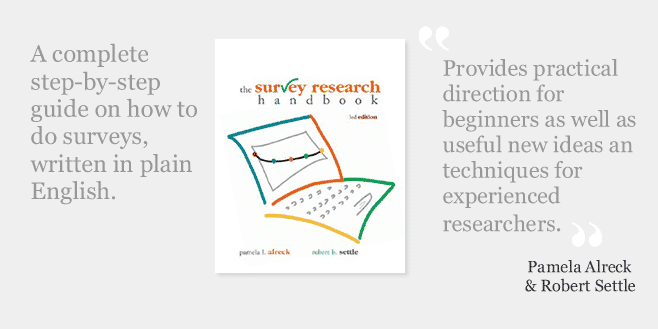Review Overview
Interesting content - 9
Easy to read - 10
Usefulness - 10
9.7
A must-read for anyone doing surveys in international development.
The humble survey is a cornerstone of international development. As Dave Algoso from Stuff Expat Aid Workers Like puts it “The savvy Expat Aid Worker manages an array of tools to help implement his or her important work…Surveys provide the EAW with raw data that allows her and her employer to demonstrate beyond a doubt that their presence is needed”.
All cynicism aside, doing high quality surveys is an important part of planning and evaluating international development programs. The problem is that many program managers and technical advisers find surveys intimidating. Even people who have been through several university-level research courses are often unsure about how to calculate the right sample size or write appropriate questions. Some even quietly do away with surveys altogether, replacing them with focus groups and interviews, even when quantitative data would have been more useful for making decisions.
If any of this sounds like you then The Survey Research Handbook (3rd Edition) by Pamela Alreck and Robert Settle is your perfect companion. According to the authors the main purpose of the book is to bring together everything you need to know to conduct a really effective survey. At the same time they’ve also gotten rid of all the complicated research techniques and methods that aren’t actually relevant in real life.
The result is a very practical, easy to follow manual. It guides you step-by-step through the entire survey process, from planning the survey, to selecting the sample, writing the questions, formatting the questionnaire, collecting and entering the data, and analysis and report writing. The language is strictly plain English and each section is accompanied by useful check-lists and examples. The authors also address many of the common survey controversies, such as whether points on a rating scale should be labelled and whether or not the demographic questions should go at the start or end.
At 385 pages (excluding appendices) it will take you a while to get through all the material, so it’s best to start reading well in advance of your next survey project. The book is written for a wide audience, including students, researchers, and people working in business, rather than international development workers specifically. So although it contains some advice regarding surveys for people with low literacy, it doesn’t cover issues such as translation and cultural adaptation in detail. It does have a section related to online surveys, but since the latest edition was written in 2004 it isn’t up-to-date with all the latest tools such as Survey Monkey, Wufoo forms or surveys on smart phones.
Despite these limitations, this is still the best guide for conducting surveys I’ve ever read. It’s a must-read for anyone who does surveys in international development, and even the most experienced quantitative researcher is likely to pick up a few useful tips. If you can’t manage to get a copy, check out our How To Guides for some top tips on survey design.




